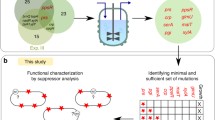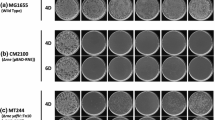Abstract
An operon fusion was constructed in which the chloramphenicol acetyltransferase gene (cat) is under the transcriptional control of the anaerobically-activated formate dehydrogenase (fdhF) gene promoter. It was used as a screening system for mutations in trans which prevent the formate-dependent anaerobic induction of fdhF gene expression. Five classes of mutants were identified. The defect in class I mutants was complemented by a plasmid (pBA11) or subclones thereof, which harbor genes of the Escherichia coli 58 min hyd (hydrogenase) gene cluster. They may comprise regulatory gene mutants. The phenotype of class II mutants was reversed by supplementing the medium with 100 μM MoO 2-4 ; WO 2-4 could substitute for MoO 2-4 in restoring anerobic induction by formate. Similarly, class III mutants were phenotypically suppressed by inclusion of 500 μM Ni2+ in the medium; these mutants were shown to carry a defective fnr gene. The mutant of class IV had a defect in a formate dehydrogenase structural gene and that of class V was unable to grow under fermentative conditions while maintaining the capability to grow anaerobically in the presence of electron acceptors.
Similar content being viewed by others
References
Ballantine SP, Boxer DH (1985) Nickel-containing hydrogenase isoenzymes from anaerobically grown Escherichia coli K-12. J Bacteriol 163:454–459
Begg YA, Whyte JN, Haddock BA (1977) The identification of mutants of Escherichia coli deficient in formate dehydrogenase and nitrate reductase activities using dye indicator plates. FEMS Microbiol Lett 2:47–50
Birkmann A, Böck A (1989) Characterization of a cis regulatory DNA element necessary for formate induction of the formate dehydrogenase gene (fdhF) of Escherichia coli. Mol Microbiol 3:187–195
Birkmann A, Zinoni F, Sawers RG, Böck A (1987a) Factors affecting transcriptional regulation of the formate-hydrogen-lyase pathway of Escherichia coli. Arch Microbiol 148:44–51
Birkmann A, Sawers RG, Böck A (1987b) Involvement of ntrA gene product in the anaerobic metabolism of Escherichia coli. Mol Gen Genet 210:535–542
Bremer E, Silhavy TJ, Weinstock GM (1985) Transposable λplacMu bacteriophages for creating lacZ operon fusions and kanamycin resistance insertions in Escherichia coli. J Bacteriol 162:1092–1099
Brosius J (1984) Plasmid vectors for the selction of promoters. Gene 27:151–160
Buck M, Miller S, Drummond M, Dixon R (1986) Upstream activator sequences are present in the promoters of nitrogen fixation genes. Nature (Lond) 320:374–378
Casadaban MJ, Cohen SN (1979) Lactose genes fused to exogenous promoters in one step using a Mu-lac bacteriophage: in vivo probe for transcriptional control sequences. Proc Natl Acad Sci USA 76:4530–4533
Chaudhuri A, Krasna AI (1987) Isolation of genes required for hydrogenase synthesis in Escherichia coli. J Gen Microbiol 133:3289–3298
Glaser JH, DeMoss JA (1971) Phenotypic restoration by molybdate of nitrate reductase activity in chlD mutants of Escherichia coli. J Bacteriol 108:854–860
Jamieson DJ, Higgins CF (1984) Anaerobic and leucine-dependent expression of a peptide transport gene in Salmonella typhimurium. J Bacteriol 160:131–136
Lee JH, Patel P, Sankar P, Shanmugam KT (1985) Isolation and characterization of mutant strains of Escherichia coli altered in H2 metabolism. J Bacteriol 162:344–352
Lennox ES (1955) Transduction of linked genetic characteris of the host by bacteriophage P1. Virology 1:190–206
Magazin M, Howe M, Allet B (1977) Partial correlation of the genetic and physical maps of bacteriophage Mu. Virology 77:677–688
Maniatis T, Fritsch EF, Sambrook J (1982) Molecular cloning. Cold Spring Harbor Laboratory Press, Cold Spring Harbor, New York
Miller JH (1972) Experiments in molecular genetics. Cold Spring Harbor Laboratory Press, Cold Spring Harbor, New York
Morett E, Buck M (1988) NifA-dependent in vivo protection demonstrates that the upstream activator sequence of nif promoters is a protein binding site. Proc Natl Acad Sci USA 85 (in press)
Pascal M-C, Chippaux M, Abou-Jaoudé A, Blaschkowski HP, Knappe J (1981) Mutants of Escherichia coli K-12 with defects in anaerobic pyruvate metabolism. J Gen Microbiol 124:35–42
Pecher A, Zinoni F, Jatisatienr C, Wirth R, Hennecke H, Böck A (1983) On the redox control of synthesis of anaerobically induced enzymes in enterobacteriaceae. Arch Microbiol 136:131–136
Pechner A, Zinoni F, Böck A (1985) The seleno-polypeptide of formic dehydrogenase (formate hydrogen-lyase linked) from Escherichia coli: genetic analysis. Arch Microbiol 141:359–363
Reitzer LJ, Magasanik B (1986) Transcription of glnA in E. coli is stimulated by activator bound to sites far from the promoter. Cell 45:785–792
Sankar P, Lee JH, Shanmugam KT (1985) Cloning of hydrogenase genes and fine structure analysis of an operon essential for H2 metabolism in Escherichia coli. J Bacteriol 162:353–360
Sawers RG, Ballantine SP, Boxer DH (1985) Differential expression of hydrogenase isoenzymes in Escherichia coli K-12: Evidence for a third isoenzyme. J Bacteriol 164:1324–1331
Sawers RG, Böck A (1988) Anaerobic regulation of pyruvate formate-lyase from Escherichia coli K-12. J Bacteriol 170:5330–5336
Shaw WV (1975) Chloramphenicol acetyltransferase from chloramphenicol-resistant bacteria. Methods Enzymol 43:737–755
Shine J, Dalgarno L (1974) The 3′-terminal sequence of Escherichia coli 16S ribosomal RNA: Complementarity to nonsense triplets and ribosome binding sites. Proc Natl Acad Sci USA 71:1342–1346
Showe MK, DeMoss JA (1968) Localization and regulation of synthesis of nitrate reductase in Escherichia coli. J Bacteriol 95:1305–1313
Waugh R, Boxer D (1986) Pleiotropic hydrogenase mutants of Escherichia coli K-12: growth in the presence of nickel can restore hydrogenase activity. Biochimie 68:157–166
Wu LF, Mandrand-Berthelot M-A (1986) Genetic and physiological characterization of new Escherichia coli mutants impaired in hydrogenase activity. Biochimie 68:167–179
Wu LF, Mandrand-Berthelot M-A (1987) Regulation of the fdhF gene encoding the selenopolypeptide for benzyl viologen-linked formate dehydrogenase in Escherichia coli. Mol Gen Genet 209:129–134
Zinoni F, Beier A, Pecher A, Wirth R, Böck A (1984) Regulation of the synthesis of hydrogenase (formate-hydrogen-lyase linked) of E. coli. Arch Microbiol 139:299–304
Zinoni F, Birkmann A, Stadtman TC, Böck A (1986) Nucleotide sequence and expression of the selenocysteine-containing polypeptide of formate dehydrogenase (formate-hydrogen-lyase-linked) from Escherichia coli. Proc Natl Acad Sci USA 83:4650–4654
Author information
Authors and Affiliations
Rights and permissions
About this article
Cite this article
Schlensog, V., Birkmann, A. & Böck, A. Mutations in trans which affect the anaerobic expression of a formate dehydrogenase (fdhF) structural gene. Arch. Microbiol. 152, 83–89 (1989). https://doi.org/10.1007/BF00447016
Received:
Accepted:
Issue Date:
DOI: https://doi.org/10.1007/BF00447016




